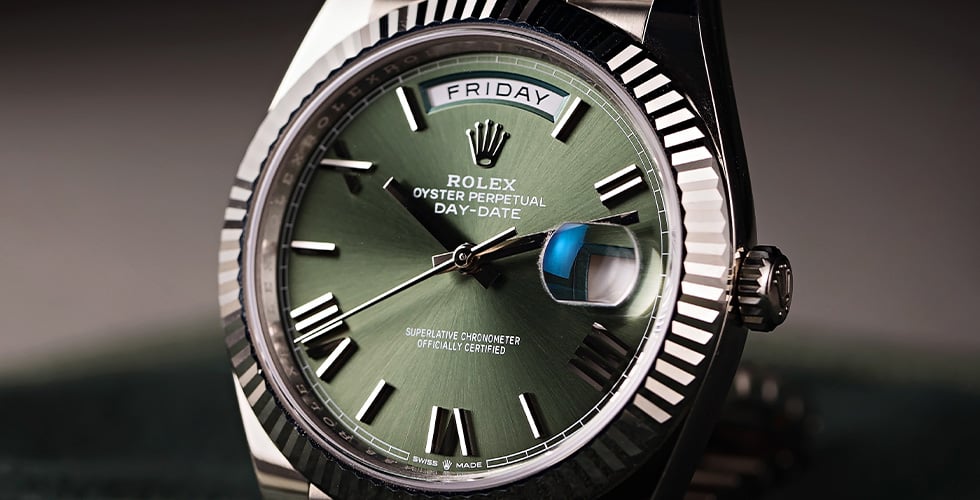A couple years ago, Rolex introduced a new Rolex Day-Date 36 model with an attractive selection of decorative Rolex stone dials, including finely crystallized green aventurine in 18k Everose gold, fiery orange carnelian in 18k yellow gold and sea-colored turquoise in 18k white gold. The timepieces, which came on President bracelets, were nothing short of spectacular.
Rolex’s Legacy of Stone Dials

It wasn’t the first time that the brand had introduced Rolex Day-Date models bearing colorful hard stone dials, nor the first time such pieces had struck buyers’ fancies. “Rolex began using stone dials in the 1970s, which was a bold move at the time,” Paul Altieri, founder and CEO of Bob’s Watches, says. “They became popular for their vibrant colors and luxurious feel, with the late ’70s and early ’80s being their peak era.”
Most often seen on the Day-Date and Rolex Datejust models, with the occasional Daytona thrown in for good measure, the colorful dials featured a rainbow of hard stones, including lapis lazuli, turquoise, malachite, tiger’s eye, carnelian, onyx, agate, jasper and coral. Highly desired for “their striking colors and natural patterns,” according to Altieri, the dials – especially in references like the Rolex 18038 with lapis lazuli and green malachite – were, and continue to be, coveted by collectors.

Unlike the sober, utilitarian tool watches that Rolex built its reputation on, the stone dial wristwatches reflected the brand’s more fanciful side: groovy, fun and surprisingly eclectic. By the dawn of the 1990s, however, the bohemian vibe that characterized the stone dial timepieces had fallen out of favor.
A Resurgence in Collectors’ Interest

Until now. Over the past year, vintage Rolex models bearing faces of colorful hard stone have been burning up secondary channels, as buyers seek design-forward wristwatches to help them stand out from the luxury pack. “Over the past year, we’ve seen a noticeable increase in interest, especially among collectors who appreciate their rarity and unique aesthetics,” Altieri says. “Collectors are drawn to stone dials for their craftsmanship. As the market shifts toward rare and distinctive designs, these pieces are becoming even more sought after.”
That’s especially true of another vaunted, near-mythical style that emerged in the ’70s. Known as “Stella Dials,” the watches were named after the Swiss firm that supplied the special lacquer and pigment used on Rolex’s dials. Their colorful lacquer dials – in shades of blue, green, red, yellow, mauve, coral, even “oxblood” – are super rare today and, as a result, uber-collectible.

Momentum also is building behind vintage Rolex watches set with faceted colored stones, from retro Oysterquartz models bearing rainbow bezels to modern Submariners whose bezels lack ceramic inserts but make up for that absence with a ring of baguette-cut blue sapphires.
There are grails to be found here – such as vintage “SARU” models from the 1980s, referring to the first Rolex watches to be adorned with colored stones, specifically blue SApphires and red RUbies in a “Pepsi”-like layout – but even your standard, run-of-the-mill gem-set Rolex is a treasure. The brand produced a relatively small portion of any given model with gems, making these factory-produced jewel watches genuine rarities and, as a result, catnip to collectors.
Beyond Rolex: Other Brands That Embraced Stone Dials
Even though Rolex rules the market for watches, gem-set or otherwise, other brands also excelled at making stone dials and adorning their pieces with flashy gemstones. Piaget is a standout. In the 1960s and ’70s, the brand earned a cult following among the glitterati for its chic stone dial timepieces, not to mention its jewelry watches. Even Patek Philippe, Audemars Piguet and Vacheron Constantin, the standard bearers for classic Swiss watchmaking, embraced hard stones in the 1970s, when their watches prioritized form, texture and design over function.
A New Era of Colorful, Gemstone-Set Watches

Now, in the post-post-pandemic era, we’re seeing a return to a design-first philosophy. The use of genuine gems is a critical aspect of the shift. Whether they’re opaque slices of stone that create a subtle difference on a dial, noticeable only among aficionados, or flashy glints of color that practically scream “Look at me!” gems offer watch lovers another way to convey who they are and what they stand for.
That helps explain why modern watchmakers are so besotted with color. From the independent maker Sylvain Berneron, whose highly praised debut model, the Mirage, featured dials of lapis lazuli and tiger’s eye, to Bulova, which just introduced a Super Seville collection of stone dial watches in collaboration with the collector group Complecto, brands are experimenting with bold and uncharacteristic uses of color. Sure, diamonds often accompany these pieces, but make no mistake: Colored stones are the new bling. And Rolex, as always, is right on hue.








